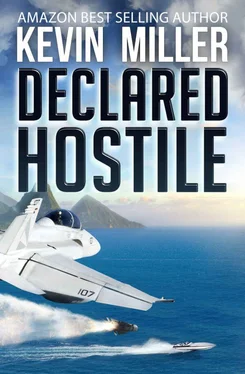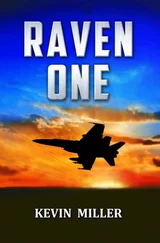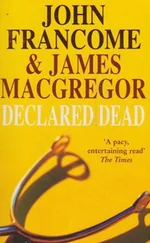Wilson checked the winds. At high speed, the ship was generating its own wind right down the deck, and Wilson didn’t think the ship would have to slow and turn to a launch heading. The weather was beautiful, as always, and offered ten miles visibility, gentle clouds floating about, scattered-variable-broken.
Once ready, Wilson signaled to Hodges, and the yellow shirt stepped up, signaling his blue-shirted apprentices to remove the wheel chocks and tie-down chains from 301. The yellow shirt now motioned 301 forward, inches from Olive’s folded wing. Hodges saluted at attention with a dozen grimy tie-down chains over his shoulders, a salute Wilson returned with a smile. He tapped the brakes to check them, and continued forward, eyes locked on his young director.
On signal, Wilson turned to head aft between the two rows of screaming jets. On Cat 3, an E-2 was hooked up with launch bar down, waiting for the two Sierras to get airborne with their SEALS. A Rhino tanker was on Cat 4.
Wilson taxied past Billy and gave him a wave as he was handed off to another director. This one took him aft along the spinning rotor blades of the helos on the angle as sailors warily watched the clearance. Wilson glanced up at the island. Hundreds of sailors in the galleries were observing, and on the signal bridge he saw the signalmen break the FOXTROT flag from the yardarm. The Stars and Stripes snapped in the stiff wind above the 4.5 acres of sovereign U.S. territory.
The helos lifted one after the other and flew straight ahead on their long journey south. Wilson now passed mere feet from the spread wings of the E-2, still watching his assigned yellow shirt and monitoring all the activity around him. He noted Ripper in 310 waiting his turn on top of the one-wire. Good .
At full power, the Hawkeye’s prop tips generated white condensation from the moist air before it lumbered down the angle and jumped into the air, cleaning up as it, too, headed south. The Rhino on Cat 4 then went into tension. As the pilot cycled the controls, the surfaces moved at full deflection, as if a bird were ruffling her feathers. Wilson saw the pilot salute as the catapult officer looked up and down the track, touched the deck, and pointed forward in a crouch. Seconds later, the thundering Super Hornet bolted forward as it accelerated down the track, attaining airspeed of 200 miles per hour in the length of a football field.
Wilson saw he would be the first “attack” bird to be shot on this event. As he was led to the catapult by a yellow shirt straddling the track, he noted Billy, Olive behind him, taxiing aft to the waist. Dozens of sailors in multicolored float coats moved about with their important tasks — or watched from the sidelines until they were needed. On signal, Wilson reached down and cranked the wingfold handle to the right to spread the wings for launch. As the wings spread, he was directed to lower the launch bar. Troubleshooters each took a side of the aircraft as they checked for loose panel fasteners and leaks. Wilson inched forward under the guidance of the yellow shirt and locked the wings in place.
“Three-zero-one, you are cleared for an immediate turn and climb,” the Air Boss radioed from the tower above. Wilson rogered him and nodded, appreciating that someone had cued the Air Boss in on the plan. The ship was pretty much heading in the proper direction, and Wilson calculated a 10-degree right turn off the cat.
Wilson raised his hands above the canopy rail as Gunner Short’s red shirts armed his gun and his one laser-guided bomb. Once arming was complete, he was directed forward until he felt tension on the holdback fitting that prevented him from moving forward. With no delay, the director extended his arms, and Wilson shoved the throttles to military power. With habits formed from hundreds of catapult shots, Wilson cycled the controls to full extension and checked the engine instruments and flight control computers. He then waited for the catapult officer to look at him. Once their eyes met, Wilson touched his helmet visor in salute and braced himself by grabbing the “towel rack” on the canopy bow. In anticipation of the shot, he locked his arms in place and waited.
His 44,000-pound airplane leapt forward and pinned him back in the seat under its sudden g. The Hornet whizzed by the blur of airplanes and sailors to his right as the deck edge rushed up. At the same time, he extended his left arm to full extension, shoving the throttles into burner to use every available second. Once airborne, the g subsided, and he was “thrown” forward in the straps as the jet rotated to a climb attitude.
Wilson grabbed the stick and glanced at the bow of the carrier as he roared past — nothing ready to launch — and followed the Air Boss’ orders with a gentle roll to the right on course. Keeping the burner plugged in, he raised the gear and flaps in almost one motion. He got the radar going and energized the targeting FLIR, setting a shallow climb angle that would allow him to best accelerate and climb to his planned 25,000 feet. The others would follow him as fast as they could in a single-file chase.
In no time, Wilson was passing 300 knots, then 400, as he began to weave between the cumulus buildups. To his left, a few miles ahead, he saw the E-2 in its slow climb to altitude, Then, on the surface, he saw the two helos heading for the contact yacht, a flight that would take them about 45 minutes. He checked his computed navigation to the expected latitude/longitude of the yacht. He had eight minutes to go and was accelerating past 500 knots.
With Colombian territorial waters on the horizon, the margin to intercept the yacht was small.
(Airborne, 100 miles northwest of Barranquilla, Colombia)
Wilson’s radar cursor bounced back and forth across his right Digital Data Indicator screen. He saw over a dozen surface “blips” he had to inspect, one by one.
He began his inspection with the radar returns at the bottom of his display and slewed the Throttle Designator Controller over each. With his thumb, he bumped the “castle switch” to the right to lock the raw return, and, within seconds, his FLIR seeker head slewed to align with the radar target. The IR images on his left screen allowed him to reject a LNG merchant tanker or a fat fishing boat and move on to the next unknown contact. With his altitude in the high teens now, he held a near supersonic airspeed in his shallow climb as he continued to inspect each synthetic blip on his screen.
Wilson was impatient. Holding too much airspeed, he was in danger of running past a contact before he could identify it or of stumbling across the yacht — with its suspected blinding laser — before he was ready. This close to the continent there was a lot of surface traffic for the yacht to “hide” among as it fled to the “safety” of territorial waters. The E-2 could help, and Wilson energized his data link and called the Hummer on the briefed frequency.
“ Condor, Ridgeline three-zero-one’s up for tasking. Any luck with Lauderdale ?”
“Negative, Ridgeline , still trying to sort all the traffic. We have Mike One Juliet, ” the E-2 controller said, referring to the guided missile destroyer Norman Kleiss, “about fifty miles east of you with a Fire Scout airborne.”
Ripper then checked in with Condor , followed a minute later by Billy Martin. Now, the E-2 had some assets to work with as it built the surface picture south of Coral Sea . Wilson feared the yacht could have doubled back or changed course toward the west and Panama; therefore, each contact would have to be identified.
But in Wilson’s gut the yacht was still heading south and closing Colombian territorial waters. He and the others had to get down there to shut the door, leaving the jets behind them to sweep up unknowns from the north in order to positively identify all the traffic.
Читать дальше












